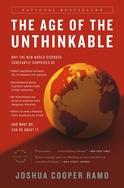Joshua Ramo
 “Among the things our leaders seem to be missing is a comprehension of the staggering speed at which these change epidemics occur: one bank fails, then fifty; one country develops an atom bomb, a dozen try to follow; one computer or one child comes down with a virus, and the speed of its spread is incomprehensible.” (Ramo, 2009, p. 10)
“Among the things our leaders seem to be missing is a comprehension of the staggering speed at which these change epidemics occur: one bank fails, then fifty; one country develops an atom bomb, a dozen try to follow; one computer or one child comes down with a virus, and the speed of its spread is incomprehensible.” (Ramo, 2009, p. 10)
“We are entering a revolutionary age. And we are doing so with ideas, leaders, and institutions that are better suited for a world now several centuries behind us.” (Ramo, 2009, p.8)
“What we face isn’t one single shift or revolution, like the end of World War 2 or the collapse of the Soviet Union or a financial crisis, so much as an avalanche of ceaseless change.” (Ramo, 2009, p. 8)
Joshua Ramo is accurately describing the challenges we are facing in our daily lives in a time of rapidly accelerating change and uncertainty. Our present leaders are as disoriented and confused as we are and not able to identify the problems now facing us, let alone solve them. We need to find our own way to survive, and thrive, through the chaos.
Fortunately, there is a surprisingly simple solution. Sahaja Yoga is uniquely suited to giving us the ability to cope and even find peace of mind and enjoyment during these difficult times. Sahaja Yoga is a meditation practice developed in 1970 and described by its founder, Shri Mataji Nirmala Devi, as the final step in the evolution of human beings. It allows us to be still like the hub of a wheel while the outside spins and whirls dizzyingly around us.
Practising Sahaja Yoga meditation helps us to see the true situation clearly by getting rid of our biases and prejudices and allowing us to make an accurate assessment of the situation as it is. Unless we see the truth, we will not be able to develop an effective action plan, both personally and as a society.
Until now, too much emphasis has been placed on details and logical thinking and rationality – all activities of the left hemisphere of the brain – in making decisions, to the exclusion of the input of the right hemisphere. Better, more livable solutions are more likely to come from the right hemisphere: the emotional, the personal, the particular, the natural world, the vision of the whole, and intuition and inspiration. Sahaja Yoga meditation brings the left and right hemispheres of the brain into balance so that they interact effectively in decision-making in individual and collective issues.
Creativity is essential for finding workable solutions to the new and unprecedented challenges of our present age. Some of our old solutions may be able to be combined in new and creative ways to solve present problems. It is often in meditation that inspiration comes to us. Being in a state of silence, without thoughts, allows the inspiration to flow through.
Resilience is important in allowing us to cope well with whatever adversity comes our way. If we live a life that is grounded, well-adjusted and emotionally stable and we lead a healthy lifestyle, we are setting the groundwork to be able to withstand many upheavals. If we are flexible, adaptable and not attached to particular ways of doing things, and can live without whatever we don’t have, our chances of surviving various crises are much enhanced. In addition to helping us to achieve the above, Sahaja Yoga meditation gives us hope and quiet optimism and an acceptance that whatever happens is for the best.
So often, when stress in society becomes too great, the rule of law breaks down, and morals and decency disappear. Practising Sahaja Yoga meditation automatically makes you a moral person. During meditation you find out for yourself how you should behave. You don’t need anyone to tell you, and you know it so clearly, so thoroughly, so deeply within your own being that you don’t want to go against it. The meditation also gives you the strength to act only for the right, to be a moral person even when there is enormous pressure to act otherwise.
Sahaja Yoga is the ideal adaptation to an environment of constant change now prevalent in our society. It is a living process; it is not static. It is not based on a set of rules, but is fluid and intuitive and flexible, and gives us the opportunity to adapt to whatever circumstances are prevailing, always within a totally moral framework. It is not a break from the moral precepts of the past, but a progression towards their logical conclusion. It is not in competition with the institutions of the past, merely the next step in their evolution to a higher, more complete and integrated manifestation. Sahaja Yoga meditation is all you will ever need to survive and thrive in “the age of the unthinkable”.
Kay Alford
Ramo, JC. The Age of the Unthinkable, Little, Brown and Co, 2009.
